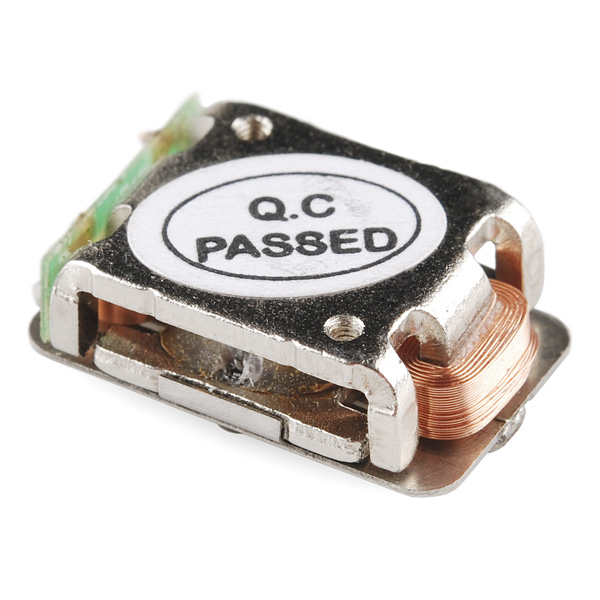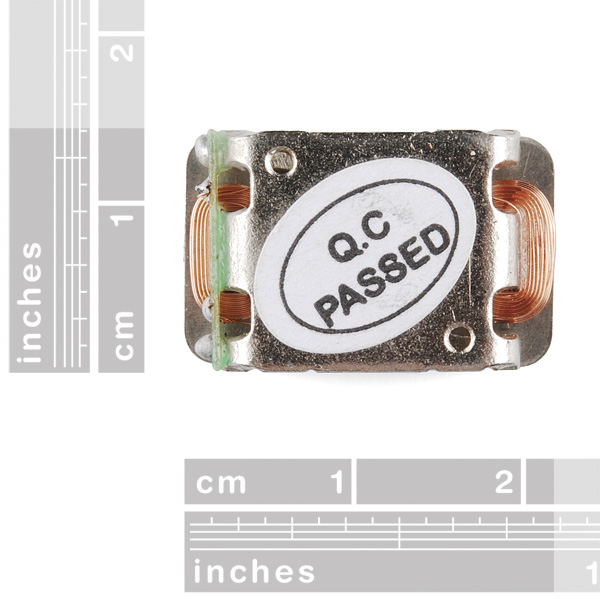Surface Transducer - Small
Surface transducers give you the awesome power to turn almost any surface into a speaker. Much like our larger surface transducer, this is essentially just a speaker except instead of a cone, the coil is attached to a pad that conducts the vibration into whatever you press it against. You can hook it up to an audio source and press it against the nearest table, wall or cardboard box. You can even put it against your head and play music directly into your skull (the ultimate surround sound).
Note: The connectors on these units are somewhat fragile so take care to prevent stressing your connection to the unit.
- Impedance: 8±5% Ohm
- Resonant Frequency: 16 +/- 0.5 kHz
- Max Operating Voltage: 12 Vpp
- Frequency Response: 300-19000 Hz
- Rated input: 1.0 W
- Maximum input: 2.0 W
- Operating Temperature: -20 to +60 °C
- 21.5 x 14.5 x 7.9mm
Surface Transducer - Small Product Help and Resources
Where do I solder to these?
Have a look at this handy picture.
Core Skill: Electrical Prototyping
If it requires power, you need to know how much, what all the pins do, and how to hook it up. You may need to reference datasheets, schematics, and know the ins and outs of electronics.
Skill Level: Noob - You don't need to reference a datasheet, but you will need to know basic power requirements.
See all skill levels
Comments
Looking for answers to technical questions?
We welcome your comments and suggestions below. However, if you are looking for solutions to technical questions please see our Technical Assistance page.
Customer Reviews
4 out of 5
Based on 3 ratings:
2 of 2 found this helpful:
Tiny, works, higher freqs mainly.
I have this mounted on my full face carbon fiber mountain bike helmet. I thought this would be akin to a tweeter, and I was right, don't expect to hear many vocals from this guy. It's highly impacted by the surface it is mounted to, my helmet is far too stiff to get much output from this guy, I hardly hear it over the bigger brother also mounted near it.
Easily distorts over 1 W.
4 of 4 found this helpful:
Amazing cause nothing does it better.
Ideal for small projects that demand big audio, also provides audio to projects without compromising water proofing. As other review said, needs to be able to resonate a surface.
Soldering these is a nightmare.
2 of 2 found this helpful:
Works great
These work great for mind control! "Voices inside people's heads" tell them to do my bidding.
Easy to solder and get running with a pair of old headphones. Note: these work without an amplifier, but some phones and tablets may not have enough umph to make them very loud. Shipping was very fast, which is greatly appreciated.





Well at least we know it passed QC ...
Oooo, these are attractivvvvveeeee,,,, must... resist... searing urge... to add to cart!!!!!!
too late.....already put it in my cart... :-P
Solder points: http://i.imgur.com/K1nm0TH.jpg
link to image
Here is a VERY similar surface transducer datasheet: http://www.daytonaudio.com/media/resources/240-614-dayton-audio-bce-1-spec-sheet.pdf
And a "how to use" information: http://www.daytonaudio.com/media/resources/understanding-and-using-dayton-audio-exciters-revised.pdf
Extracted from: http://www.daytonaudio.com/index.php/bce-1-22-x-14mm-bone-conducting-exciter.html
Are you sure that the impedance is 8 Ohms? when I measure with multimeter the impedance is 4ohms. Is the measure wrong?
Impedance has in it a Resistance component .. but they are Two Different, but yet related things in the measurement world. A multimeter only measures resistance (via a DC voltage).
for a simple discussion on it see: http://www.bcae1.com/resvsimp.htm
OK, got one of those... Am trying to connect it. I see the 2 minuscule solder pads on one end, but is there a + and a - or it doesn't matter?
Also: will this be more or less sensitive to signal than the mini speakers you sell here?
Can someone tell me how one of these sounds when pressed against the back of their skull? Also, when it is being used listen to music as a "headphone" how well can others hear this?
long-forgoten question, but i'll still reply. they sound amazing! People can actually hear the sound caused my my skull's vibrations
Can it be made loud enough to really surprise a sleeping person if you press it against their forehead?
Hehe!
To answer your question it probably depends mostly on how deep of a sleeper they are and how easily they are surprised. I would guess it would be about the level of someone speaking in the room. Also, please provide video proof once you figure out the answer.
anyone find a datasheet for this part?
or can we at least get a spec on the thickness? I have an idea for a USB powered set of speakers but i want to embed these transducers in my material.
I would also love a data sheet. In the meantime the dimensions listed in the description match my measurements.
Don't press it against your skull. The reverberation is unbearable. ;)
Can we use this transducer as a microphone?
I am looking to make a spring reverb in a homemade tank and would be curious to see if this would work as both the input and output transducer for the tank. Any way to get a peak at what this looks like with the top plate taken off? I may want to put a less bulky plate on so there is more wiggle response for the spring.
Any insights?
would I need to add power to this if connected to a tablet, and would it work to connect to my wall for surround sound?
They are very small, so you probably won't get too much in regards to 'surround sound' unless you hooked up a large number of them. Otherwise, you just need to hook it up to an audio jack.
Completely new to this, could some please explain how i would wire this to say a 3.5 mm jack. Where to attach the wires to the transducer and such.
If you look at the 3rd picture of the transducer, you can see two little solder blobs on the left side sticking out from the green pcb connection. Those will be your connection points for your wires to an audio jack.
Is there any datasheet for this transducer?
It seems surprising the resonant frequency is 16KHz. I'd more expect something like 16Hz, but the frequency response doesn't go lower than 300 Hz. I want to add a 60Hz hum effect to a battery-powered project and can't tell whether I need to get the larger surface transducer.
Is there a full datasheet on these things? with the mechanical drawings and all..
Being completely new at this stuff, could i not just solder a 3.5mm audio jack onto this sucker and plug it into my ipod?
I did this to see what happened with these small ones, too. They work fine. It is interesting to place the connected speakers onto various surfaces- I put mine on pizza pans, and they were loud, if tinny. And pressing them against my skull worked, too. Weird.
That's what I did with the large transducers... works like a charm.
But how would you go about attaching an audio jack to it?
What size are the two threaded holes on the bottom?
I second this question. I just received my pair today, they sound pretty good pressed against cardboard with my finger, but the thread size would be really helpful for a more permanent installation.
If I am not mistaken it is a 1-64. McMaster has screws - get the 1/8" long ones.
I didn't have those on hand, but I will try before tapping. Thanks. Once we know for sure, let's make sure it doesn't get lost in the shuffle.
For what it's worth, I used "standard" eyeglass micro-screws and the thread seemed to work well. Added a tiny drop of threadlocker just in case, but I'm sure i didn't need to.
They don't fit quite right, but I got some 0-80 brass screws to just bite. I could hold them reliably with these, I think, but I am thinking I will just tap them for 0-80 or something like that. It would be nice to know rather than guess.
What is the difference between these and the "Large Surface Transducers"? Will the large version be able to output with more power - thus more volume?
yes. watch the product video last week for a size comparison, these are significantly smaller and lighter.
Maybe add a link to the video here? (or better, on each product's page?)
I can do that.
can i use 2 of these for an Controller's vibration feedback?
you probably want something more like this: http://www.sparkfun.com/products/8449
would it be practical to use this to turn a PCB into a speaker?
I'm not an expert (yet) but I think the vibrations would generate unwanted voltages in the caps. Dave Jones from the EEVblog has a video about that with oscilloscope probes.
I believe vibrations would also modulate crystal frequencies, right?
That would be an interesting way to make a basic FM transmitter.
Any possibility of getting a photo of the connector?
sure. it's a small PCB you can see in the first pic (the edge of it anyways), and there are two small solder tabs.
Currently wondering what 5 of these would be like in a sports headband, routed into a low power 5.1 surround sound while playing an MMO. :D
Not trying to sound pessimistic, but 5 transducers might be overkill.
Much of how we perceive auditory spatialization depends on the physical characteristics of the external ear, as well as a time and intensity difference between right and left. With bone conduction, the ability to spatially locate a sound source is vastly decreased, as bone conducts very fast, and intensity differences are much smaller. As an example, underwater hearing is nearly all done by bone conduction (since the water in the external ear canal dampens vibrations of the tympanic membrane), and if you've ever tried to localize a sound source underwater, you know how difficult that can be. The sound just seems to come at you from all directions, almost like coming from within your head.
I think you would get virtually identical results with just 2 transducers (placed on the mastoid processes - the bony "bump" behind and below your ears) and a big ass sub (cause everyone needs a big sub).
That'll likely take some serious experimentation, as each one should have its own isolated 'cone' for optimal output, but that's a great idea!